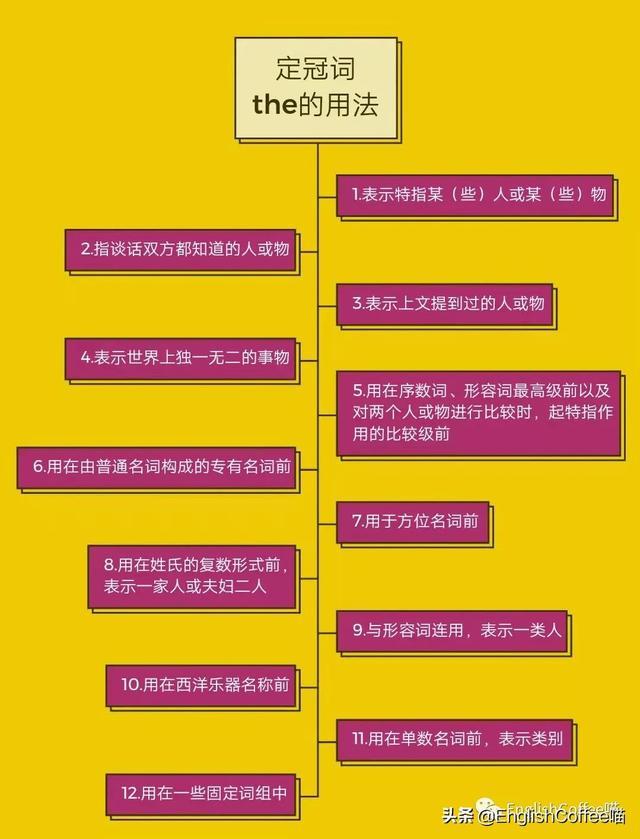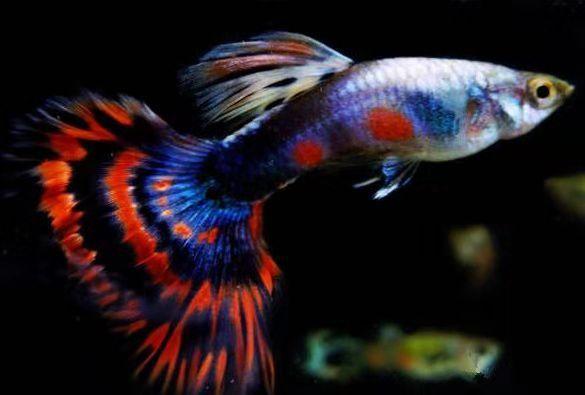冠词概述
1.冠词的定义
冠词是用在名词之前,帮助说明该名词含义的一种虚词。它不能脱离名词而单独存在,也不能单独作句子成分。
2.冠词的分类
冠词分为不定冠词和定冠词两种。不定冠词有a和an,定冠词是the。
冠词的用法
1.不定冠词的用法
不定冠词a和an用在单数可数名词之前。不定冠词a用于发音以辅音音素开头的名词前,an用于发音以元音音素开头的名词前。
Have you got a match?
你有手表吗?
Across from the park is an old hotel.
在公园对面是一个旧旅馆。

(1)表示某类人或物中的任意一个。
My brother has a soccer ball,but I don't.
我哥哥有一个足球,但我没有。
Have you seen a doctor about it yet?
关于它你看过医生了吗?
(2)表示第一次提到的人或物。
This is an English book.I think it's Li Lei's.
这是一本英语书。我认为它是李磊的。
(3)表示一类人或物,此时a/an可不译成中文。
Is there a restaurant near your house?
你家附近有餐馆吗?
A horse is a very useful animal.
马是一种很有用的动物。
(4)表示某人或某物,但不具体说明是何人或何物。
A girl is waiting for you.
有个女孩在等你。
A dictionary can help us to study English.
有本词典有助于我们学习英语。
(5)表示数量,有“一”的意思,但没有one强烈。
Please give me a pen.
请给我支钢笔。(侧重pen,而非其他物品)
She has only one knife.
她只有一把小刀。(侧重数量“一把”,而非“两把、三把”)
(6)表示单位量词,意为“每一”,相当于every。
I get paid once a month.
我每月领一次钱。
The other ten percent use it at least three or four times a week.
其他百分之十的学生每周上网至少三到四次。
(7)用在序数词前,表示“又一,再一”。
Let me try a third time.
让我再试一次。
(8)用在某些物质名词或抽象名词前,表示“一阵、一份、一类、一场”等。
There was a very heavy rain last night.
昨晚下了一场很大的雨。
It is a pleasure to work with you.
和你一起工作是件乐事。
(9)用于专有名词前,表示“一个、一种、一类”等。
I met a John Smith at a friend's house.
我在一位友人的家中遇见了一位姓史密斯名叫约翰的人。
(10)不可数名词。如history(历史),population(人口),knowledge(知识),world(世界)等,在表述其某一部分或某一方面的内容、概念时,前面常加不定冠词。
China is a large country with a long history.
中国是一个拥有悠久历史的大国。
The city has a population of ten million.
这座城市有一千万人口。
(11)用在固定词组中。
a lot of 许多
a little 一点儿
a few 一些,几个
have a look 看一看
take a message for 为······捎口信
once upon a time 从前
have a talk 谈话
after a while 过一会儿
have a cold 感冒
as a result 结果
have a headache 头痛
have a rest 休息
make a mistake 犯错误
have a swim 游泳
go out for a walk 出去散步
have a fever 发烧
have a good time 玩得高兴
make a face 做鬼脸
a moment ago 片刻之前
make a living 谋生
do sb. a favor 帮助某人
take a seat 坐下
in a word 总之
in a hurry 匆忙
2.定冠词的用法

(1)表示特指某(些)人或某(些)物。
The white model plane is hers.
那架白色的模型飞机是她的。
Some think that the lives of the performers are made up.
一些人认为表演者的生活是扮演的。
That's the school that Terry went to.
这是特里上过的学校。
(2)指谈话双方都知道的人或物。
Take something to read on the plane.
带点什么在飞机上看。
(3)表示上文提到过的人或物。
I ordered a pizza and salad. The pizza was nice but the salad was disgusting.
我点了一份比萨饼和一份沙拉。比萨饼很好但沙拉令人恶心。
(4)表示世界上独一无二的事物。
The rain stopped and the sun came out.
雨停了,太阳出来了。
(5)用在序数词、形容词最高级前以及对两个人或物进行比较时起特指作用的比较级前。
The first time I flew on a plane I was really nervous.
我第一次乘飞机真的紧张。
The best supermarket is on Center Street.
最好的超市在中心街。
(6)用在由普通名词构成的专有名词前。
The Big Screen is more expensive than most cinemas.
大屏幕电影城比大多数影院贵。
(7)用于方位名词前。
My parents lived in a small far away village in the north.
我的父母住在北方的一个遥远的小村庄里。
(8)用在姓氏的复数形式前,表示一家人或夫妇二人。
The Blacks live next to us.
布莱克夫妇住在我们隔壁。
(9)与形容词连用,表示一类人。
We should help the blind to cross the road.
我们应该帮助盲人过马路。
(10)用在西洋乐器名称前。
He wanted his children to learn the piano.
他想让他的孩子学钢琴。
Can you play the guitar?
你会弹吉他吗?
(11)用在单数名词前,表示类别。
The tiger is a fierce animal.
老虎是一种凶猛的动物。
(12)用在一些固定词组中。
all the time 一直
all the year around 一年到头
at the same time 同时
at the age of 在……岁时
at the moment 此刻
at the beginning of 在……开始时
by the way 顺便说
at the end of 在……结束时
in the morning 在早上
in the afternoon 在下午
in the evening 在晚上
at the foot of 在……脚下
in the daytime 在白天
in the middle of 在……中间
in the past 在过去
with the help of 在……的帮助下
the next year 第二年
look the same 看起来一样
in the open air 在户外
the day before yesterday 前天
in the end 最后
on the other side of...在……的另一边
3.零冠词(不用冠词)的情况

(1)在表示国名、地名、人名等专有名词前。
China's population is the largest of any country in the world.
中国人口是世界上所有国家中最多的。
Blue Moon is good,but Miller's the best in town.
蓝月亮影院好,但米勒影城是城里最好的。
(2)名词前已有作定语的指示代词、物主代词、不定代词或名词所有格时。
The band plans to go on tour this year.
乐队今年计划去巡回演出。
I'm sure you don't want to listen to all my problems.
我确信你不想听我说所有问题。
(3)不可数名词和复数名词表示一类人或物时。
We like rice.
我们喜欢米饭。
I like oranges.
我喜欢橘子。
|
注意:某些不可数名词表示具体意思时,要加冠词。 The meat will be bad if it isn't kept cool. 肉如果不冷藏就会腐败 |
(4)在星期、月份或节日前。
It was raining on Monday.
星期一在下雨。
The theatre opened in May.
这家电影院五月开业。
Merry Christmas and a happy New Year everyone!
各位圣诞快乐,新年快乐!
(5)在称呼语或表示头衔的名词前。
Uncle Wang is going to mend my bike.
王叔叔打算修理我的自行车。
(6)在三餐、球类运动及学科名词前。
We had supper in a small Italian place.
我们在一家意大利小店吃晚饭。
I'm going to practice basketball every day.
我打算每天练习篮球。
My favorite subject is science.
我最喜欢的科目是科学。
重点拓展
|
1.如果三餐名称前有形容词修饰时,应加冠词。 He had a quick breakfast and rushed off to work. 他匆忙吃完早餐,赶紧去上班了。 2.球类名称用于指具体物体时,应用冠词。 —Where is the football? ——那个足球在哪儿? —It's under the desk. ——它在书桌下面 |
(7)在与by连用的交通工具名词前。
Do you go to school by bus or by train?
你上学乘公共汽车还是乘火车?
She goes to school by bike.
她骑自行车去上学。
小贴士
|
交通工具名词不与by连用时,其前要加冠词。 Do they take the bus to school? 他们乘公共汽车去上学吗? I ride my bike to the subway station. 我骑自行车去地铁站 |
(8)在“专有名词 普通名词”构成的街名、路名、山名、食物名等之前。
Greenwood Park is the best place to go to on weekends.
格林伍德公园是周末最好的去处。
(9)在某些固定词组中的名词前。
day and night 日日夜夜
at night 在夜晚
at noon 在中午
at home 在家
at work 在上班
at dinner 在吃饭
at breakfast 在吃早餐
after school 放学后
by hand 用手工
for example 例如
in danger 在危险中
in time 及时
on time 准时
in surprise 惊讶
in trouble 处于麻烦中
on foot 步行
pay attention to 注意
take care of 照看
take part in 参加
go to bed 上床睡觉
by mistake 错误地
on show 在展出
冠词的位置
1.不定冠词的位置

(1)通常情况下,不定冠词放在名词之前。
There was a hole in the fence.
栅栏上有一个洞。
(2)当名词前有形容词修饰时,不定冠词一般放在形容词之前。
It's such a long way from here.
离这里有一段很长的路。
(3)当名词前的形容词被so,how,as等副词修饰时,不定冠词要放在形容词和名词中间。
I've never seen so nice a film.
我从来没看过如此好的电影。
He is as good a student as Tom.
他和汤姆一样是好学生。
(4)当单数名词被such,what,many 等修饰时,不定冠词要放在这些词之后。
He is such a clever boy that we all like him.
他是一个如此聪明的男孩,我们都喜欢他。
What a wonderful painting!
多么美的一幅油画!
(5)当单数名词前有形容词和quite,rather,very修饰时,不定冠词要置于quite或rather之后,very之前。
He is quite a clever boy.
他是一个相当聪明的男孩子。
This is rather a useful book.
这是一本相当有用的书。
He is a very clever boy.
他是一个很聪明的男孩子。
2.定冠词的位置

(1)定冠词通常置于名词前,若名词前有形容词修饰时,定冠词应放在形容词之前。
The book you gave me is now on the bookshelf.
你给我的那本书现在在书架上。
The new book is worth reading.
这本新书值得一读。
(2)当定冠词与all,half,both,double等词连用修饰名词时,定冠词应置于这些词之后。
Of all the girls she sings best.
在所有女孩子中她唱得最好。
Half the bananas are bad.
一半香蕉是坏的。
Both the teachers are very popular in our school.
在我们学校这两个老师都很受欢迎。
(3)当定冠词与表示倍数、分数的词连用时,定冠词要置于这些词之后。
Your room is twice the size of mine.
你的房间是我的房间的两倍大。
巧学妙记
|
冠词用法口诀 |
|
名词前需两冠,定冠与不定冠; 可数单数前,a或an不可删; an在元音前,a置辅音前; 如果是特指,须用定冠the; 复数或不可数,泛指不加冠。 |
有无定冠词的区别
在有些短语中,名词前加定冠词与不加定冠词,意义很不相同。

真题链接
1.We will have()reading festival this term, and we can't wait for it.
A.a B.an C.the D./
2.Teachers always tell us to try to be()honest student today and ()useful man tomorrow.
A.a;an B.an;a C.an;an D.a;a
3.—Who is()girl behind the tree?
—Which one? The one with()umbrella?
A.a;the B.the;an C.the;a
4.Jack often plays()piano and he wants to be a pianist when he grows up.
A.a B.an C./ D.the
5.—My father often goes to work()on foot.
—It is good for health. But my father drives()car.
A.the;the B./;an C./;the D.the;/
6.I think playing()football is a good way to learn the spirit of teamwork.
A.a B.an C.the D./
答案解析
1.A 句意:我们这学期将会有一个读书会,我们迫不及待了。泛指“读书会”,且festival是可数名词,其前应用不定冠词;reading以辅音音素开头,故选A。
2.B 句意:老师总是告诉我们现在要努力做一个诚实的学生,将来做一个有用的人。泛指某类人物中的任何一个,用不定冠词;honest以元音音素开头,第一空用an;useful以辅音音素开头,第二空用a,故答案为B。
3.B 句意:—树后的那个女孩是谁?——哪个?打着一把伞的那个吗?受介词短语behind the tree 限定,第一空填入定冠词;泛指“伞”这类事物中的任何一把,第二空填不定冠词;umbrella以元音音素开头,前面用不定冠词an,故选B。
4.D 句意:杰克经常弹钢琴,他长大后想当一名钢琴家。“play 西洋乐器”结构中,乐器名词前要用定冠词the,故选D。
5.C 句意:——我爸爸经常步行上班。—那有益于身体健康。但是我爸爸开车去上班。on foot是固定搭配,不用冠词;特指“我爸爸开车”,第二空用the,故答案为C。
6.D 句意:我认为踢足球是学习团队精神的一个好方法。play football踢足球,为固定搭配,不用冠词,故答案为D。
,




